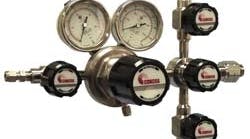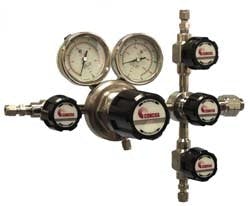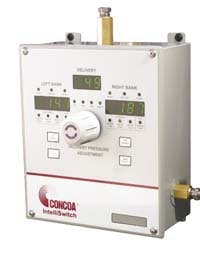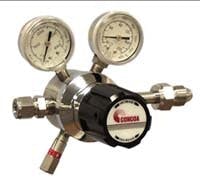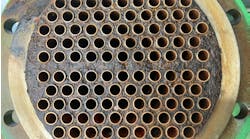Properly deliver compressed gases
The volumes and types of compressed gases used as chemical precursors, catalytic reagents and process materials continue to grow. Some of these gases are toxic, corrosive and reactive in the chemical processing environment and so clearly pose hazards. However, even benign inert gases can be a challenge if they aren’t handled properly.
From large petrochemical units to tiny pharmaceutical pilot plants, day-to-day operations depend upon providing these gases in a controlled, safe and environmentally conscious manner. Safe delivery requires strict adherence to a plethora of formal codes and specifications. Failure to achieve safe operation isn’t an option.
Planning begins with understanding that all compressed or cryogenic gases are considered hazardous materials and must be given the respect and importance that implies. Fire, health and safety, as well as environmental codes dictate the need to store, use and contain hazardous materials in a safe and effective manner. The cost for failing to comply makes it imperative to use the best available technology, material and procedures for pressure and flow control systems. Materials and systems selected must be compatible not just with the specific gas being used, but also with the environment to which they are subjected and the pressure and flow the process entails.
At the practical level, safety involves the following procedures, which also can improve efficiency:
- venting;
- purging;
- manifolding;
- locking out equipment;
- matching gas handling hardware to the process gases being used; and
- managing delivery of raw materials into processes with high-quality pressure and flow control equipment.
Venting
Venting is the discharge or release of a gas from a contained system or device. Any venting or release of hazardous gases, whether intentional, e.g., as part of a cylinder change, or as the result of system or component failure, must be contained and properly handled. In many cases uncontrolled release of toxic or acutely hazardous gases in even small amounts poses safety hazards and the possibility of hefty fines. It, therefore, is imperative to assess potential sources or conditions that could cause venting from the gas delivery system. You must arrange for control, containment, and in the case of toxic or acutely hazardous gases, delivery to appropriate disposal, scrubbing or abatement systems.
Always keep in mind that all compressed or cryogenic gases are considered hazardous materials. Toxic and acutely hazardous gases obviously demand rigorous oversight and scrutiny. But don’t forget the risks posed by the uncontrolled release of inert gases such as nitrogen, argon and carbon dioxide — in confined spaces, these gases can present asphyxiation hazards that must be appropriately addressed. Venting from the cylinder, container, cylinder connection, pressure regulator or control devices, pressure relief device and pipeline are areas of concern that should be evaluated. Then, implement systems or procedures to preclude hazardous outcomes.
From a procedural standpoint, it’s essential to have a receipt and inspection procedure in place for all compressed gas containers delivered onsite. For toxic or acutely hazardous gases, using portable leak-detection equipment and training receiving personnel is the best method to ensure that leaking cylinders or containers aren’t taken into inventory.
Dealing with leaks from containers already onsite depends upon the specific gas and whether a pressure or safety relief device is located on the cylinder or as part of the cylinder valve. In the case of most extremely toxic gases, there’s no pressure or safety relief device on the container or cylinder valve. Where relief devices are part of the cylinder or container, they may be burst-disk safeties in the case of inert or less hazardous gases, or fusible plugs that only release contents when exposed to extreme heat, as with many flammable gases like hydrogen.
Storage location or enclosures are the only methods of containing product venting as a result of failure of the cylinder valve or safety relief device. National and local fire, health and safety codes specify what can be stored where and standoffs, minimum allowable distances from emergency exits, electrical hazards and ventilation systems. In general, toxic and acutely hazardous gases must be stored in designated areas with containment means such that a release of cylinder contents can be safely vented to abatement systems or scrubbers.
Figure 1. This regulator features a captive vent kit and a deep purge assembly that ensures virtually zero release of gases.
Address venting from cylinder connections, pressure regulators, pressure relief devices and pipeline sources by selecting appropriate equipment and systems that deal with these sources and allow for system purging. The primary sources of leaks from pressure regulators are connections, diaphragm seals, or in the case of diaphragm failure, through the regulator bonnet. So, select a regulator or pressure control device that comes as complete as possible, including gauges, valves or accessory options, with a Helium leak certification of at least 1 × 10-8 cc/sec from the manufacturer. Figure 1 shows one example, a regulator with a Type 316L stainless steel diaphragm, a pipe-away captive vent kit and pipe-away pressure relief device.
It’s important to note that the pressure relief devices included on pressure regulators aren’t designed to protect downstream pipelines, equipment or processes, but only regulator components or assemblies. To protect pipelines from rupture or venting, use separate dedicated pressure-relief devices that are preset and capable of piping any emissions to appropriate abatement systems or areas of release.
Purging
Purging is the use of an inert gas to repetitively dilute a hazardous gas to a level that’s safe for venting to scrubbers or release on disconnection of system components. Nitrogen typically serves as purge gas, but argon is preferred for applications in which nitrogen potentially could enter into undesirable reactions in the process stream. For cylinder connections, there will be the need to disconnect and reconnect every time a cylinder is changed. It’s best to isolate the connection and repeatedly purge with an inert gas using a deep purge assembly. This restricts the area being vented and purged solely to the cylinder connection itself and allows for safe venting of a diluted gas stream to scrubbing systems.
Purging toxic, corrosive or reactive gas systems offers added benefits above safety and environmental compliance — including increased system service life and improved gas purity. This results from eliminating corrosion or reactions that occur when the system or the reactive gas it contains is exposed to ambient air that contains moisture and oxygen.
First diluting, purging and venting the area exposed to ambient air or, if needed, the entire system, can reduce the need to replace regulators or system components. In corrosive or reactive systems that don’t employ a purge mechanism, it’s not uncommon for regulators to fail after three months of use. If a deep purge assembly is employed, the pressure regulator should be able to remain in service for six months or more, provided proper purging is done before cylinder connection and removal from the system.
It’s crucial that purge gas not come from a bulk tank or pipeline but instead from a dedicated purge source that supplies only that specific process gas. This is necessary to prevent any cross-contamination or hazard that can result from the process gas entering the purge source supply. For inert or nontoxic gas systems, using a purge can eliminate ambient air impurities from the process stream, which can yield improved process control or results.
Manifolding
Manifolding is the connection of multiple cylinders or containers of the same gas to a common supply line that goes to a pressure control device or process. This can be as simple as two cylinders connected to a single pressure regulator using flexible hose assemblies as in a protocol switchover station, or as complex as a fully automatic switchover that can interface with remote alarms or process monitoring programs (Figure 2).
Figure 2. Fully automatic units are available for almost all flow and pressure ranges and can tie in to alarms and monitoring systems.
Manifolding isn’t as simple as it might seem — the specific process and gas involved dictate design and functions of needed equipment. Where possible the system should allow future expansion to accommodate more cylinders without the need to shut down the process. Features to look for in the manifold design are diaphragm isolation valves for leak integrity and positive closure, metal-to-metal seals with a modular design that allows for system expansion, high-quality materials of construction, preferably Type 316L stainless steel, and high-quality, appropriately rated flexible hose assemblies with integral check valves that prevent backfilling of cylinders and reduce system exposure to ambient air.
Manifolding offers the benefits of reduced risk of hazardous gas release and improved process control. Because more material is available to run the process, cylinder change-outs will be less frequent and can be planned better. The resulting consistency of supply to the process should yield a better outcome by eliminating the introduction of impurities and the variation that comes from changing cylinders in mid-process. Allowing one system to supply multiple processes can result in improved process yields as well as reduced overall cost and number of cylinders or containers onsite.
Locking out equipment
Security and safety is of critical importance to any user of potentially toxic, hazardous or flammable substances, especially since 9/11. Control of access to the materials is crucial. This control must involve more than just limiting who can enter certain areas and must extend to what can be done to the process once access is gained.
Manifolding cylinders so that a common source supplies various processes can ease control of delivery. Toxic or acutely hazardous gases are typically already in areas with restricted access, monitoring, and valve lockouts that prevent dispensing material without appropriate oversight and safety. Often overlooked, however, is the security and safety of what are deemed to be less hazardous inert or flammable gases such as nitrogen, argon and hydrogen. Yet, for instance, the absence of nitrogen during a blanketing process or while purging a line during a system turnover can be as catastrophic as a toxic release if it results in exposure of reactive compounds to air.
Make sure valve lockouts are appropriate and monitored; restrict access to gas storage and use areas; properly train plant personnel in system function and design; and select the right equipment and maintain it correctly.
Keep acutely hazardous gases in a restricted access area or enclosure with online gases in a locked gas cabinet or appropriately constructed bunker. There should be emergency shutoff valves that actuate by manual, remote or process controlled functions when either an area gas monitor detects a leak in the storage or process area, an excess flow condition occurs or when process or security alarms or monitoring devices trip. Pressure control settings must be field-adjustable to specific safeguard limits to ensure that downstream relief devices or system components are not actuated or compromised accidentally or intentionally.
Perhaps the greatest increase in safety comes from removing to the maximum extent possible compressed gases from process or quality control areas. This allows for better system design, control and security than if compressed gases are dispersed throughout the plant.
Matching gas handling hardware
This can only be accomplished by employing appropriate total-gas-management design principles and specifying systems based on compatibility of materials of construction, necessary flow and delivery pressure, as well as the desired degree of monitoring and control. For reactive or corrosive gases, the materials of construction generally should be Type 316L stainless steel or electroless nickel-plated brass for acid-forming gases, with either Type 316L stainless steel or Hastelloy internals. With inert or non-reactive gases, the properties of the gases themselves determine whether to use barstock brass either bare or chrome-plated.
Additionally, consider the exterior environment to which the gas control equipment is exposed. In many chemical plants, the surrounding ambient environment may be as corrosive to the exterior of systems as if they were in corrosive service. Even for inert gas applications it’s common for the gas handling equipment of choice to be stainless steel or at least chrome-plated. Just because the regulator or manifold is made of the right material doesn’t mean it will perform the function and requirements of the end use.
Managing delivery
Many applications require high flow capabilities for process gases that can only be met by regulators with unique features that provide the capacity without sacrificing accurate pressure control. For instance, a balanced valve-and-seat assembly allows for flow rates exceeding 6,000 std. ft3/hour with accurate pressure control, which is achieved by equalizing forces that act on the internal valve assembly such that it is balanced across a wide range of flow conditions (Figure 3).
Figure 3. This unit can provide high flow rates while still maintaining pressure control accuracy.
When a process requires high pressures either to actuate valves pneumatically or inject process gases, a regulator that uses a Type 316L stainless steel piston as the pressure control and sensing element, not a flexing diaphragm, is a good choice. It not only can withstand pressure up to 6,000 psi but also can deliver that pressure many thousands of times without failure.
A key component of process control is the ability to monitor the process in real time using a valve that delivers an accurate sample to gas chromatographs or other analyzers. When the reaction or sample is at elevated temperature and pressure, you must use a specifically designed pressure-control device to maintain the sample integrity or in some cases vaporize the sample prior to injection into the analyzer. These regulators generally feature all Type 316L stainless steel construction and high-temperature seat material, and can be either electrically or steam heated. Efficient heat exchange between the heating element and the body of the regulator is critical. Electrically heated units must incorporate explosion-proof housings and be fully approved by UL, CSA and ATEX.
Gases used in sufficient volume to warrant it should be dispensed to use points from a central gas management system or manifold incorporating a primary supply source of an adequate number of cylinders or containers and a reserve or secondary supply source of an equal number of cylinders that automatically goes online to supply the process without interruption or change in process line pressure. Where possible, a complete system designed to provide the correct material of construction and the required flow and pressure with the desired degree of monitoring and alarm function yields the best result for both safety and efficiency.
Larry Gallagher is specialty gas products manager for CONCOA, Virginia Beach, Va.; e-mail him at [email protected].
